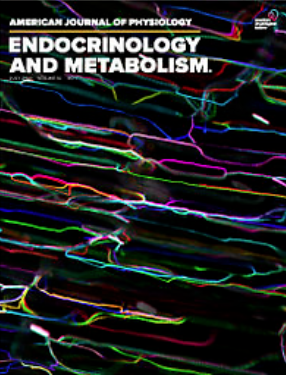中链甘油三酯特异性食欲受肝脏中链脂肪酸的β-氧化作用调节
IF 3.1
2区 医学
Q1 ENDOCRINOLOGY & METABOLISM
American journal of physiology. Endocrinology and metabolism
Pub Date : 2024-04-10
DOI:10.1152/ajpendo.00031.2024
引用次数: 0
摘要
由于长链甘油三酯(LCTs)具有导致肥胖的特性,大多数有关脂肪食欲的研究都集中在长链甘油三酯(LCTs)上。相反,中链甘油三酯(MCTs)则具有抗致肥作用;然而,中链甘油三酯摄入量的调控仍然难以捉摸。在这里,我们证明了小鼠能区分中链甘油三酯和低链甘油三酯,而且对中链甘油三酯的特异性食欲受肝脏β-氧化作用的支配。我们培育了肝脏特异性中链酰基-CoA脱氢酶(MCAD)缺乏(MCADL-/-)的小鼠,并在为期8天的双瓶选择试验中分析了它们对中链脂肪酸和低链脂肪酸溶液的偏好,这些溶液使用的是三辛酸甘油酯(C8-TG)、十三烷酸甘油酯(C10-TG)、玉米油和猪油。此外,我们还利用舔微结构分析来评估 MCTs 和 LCTs 溶液的适口性和食欲。最后,我们测量了口服脂肪2小时后下丘脑中与脂肪摄入相关的基因(Galanin、Qrfp和Nmu)的表达水平。与对照组小鼠相比,MCADL-/-小鼠对MCT溶液的偏好明显降低,而对LCT的偏好没有改变。舔食分析表明,MCADL-/-小鼠仅对MCTs溶液的食欲明显下降,而对MCTs和LCTs溶液的适口性则不受影响。口服 C8-TG 会提高对照组小鼠下丘脑加兰宁的表达,但 LCTs 不会,而 MCADL-/- 小鼠的这种反应会减弱。总之,我们的数据表明,肝脏β氧化是MCTs特异性食欲所必需的,但不是LCTs特异性食欲所必需的。摄入 MCTs 后,下丘脑加兰宁的诱导依赖于肝脏β-氧化,可能参与了 MCTs 特异性食欲的调节。本文章由计算机程序翻译,如有差异,请以英文原文为准。
Medium-Chain Triglycerides-Specific Appetite is Regulated by the β-oxidation of Medium-Chain Fatty Acids in the Liver
Most studies on fat appetite have focused on long-chain triglycerides (LCTs) due to their obesogenic properties. Medium-chain triglycerides (MCTs), conversely, exhibit anti-obesogenic effects; however, the regulation of MCTs intake remains elusive. Here, we demonstrate that mice can distinguish between MCTs and LCTs, and the specific appetite for MCTs is governed by hepatic β-oxidation. We generated liver-specific medium-chain acyl-CoA dehydrogenase (MCAD)-deficient (MCADL-/-) mice and analyzed their preference for MCTs and LCTs solutions using glyceryl trioctanoate (C8-TG), glyceryl tridecanoate (C10-TG), corn oil, and lard oil in two-bottle choice tests conducted over 8 days. Additionally, we employed lick microstructure analyses to evaluate the palatability and appetite for MCTs and LCTs solutions. Finally, we measured the expression levels of genes associated with fat ingestion (Galanin, Qrfp, and Nmu) in the hypothalamus 2 h after oral gavage of fat. Compared to control mice, MCADL-/- mice exhibited a significantly reduced preference for MCTs solutions, with no alteration in the preference for LCTs. Lick analysis revealed that MCADL-/- mice displayed a significantly decreased appetite for MCTs solutions only, while the palatability of both MCTs and LCTs solutions remained unaffected. Hypothalamic Galanin expression in control mice was elevated by oral gavage of C8-TG but not by LCTs, and this response was abrogated in MCADL-/- mice. In summary, our data suggest that hepatic β-oxidation is required for MCTs-specific appetite but not for LCTs-specific appetite. The induction of hypothalamic galanin upon MCTs ingestion, dependent on hepatic beta-oxidation, could be involved in the regulation of MCTs-specific appetite.
求助全文
通过发布文献求助,成功后即可免费获取论文全文。
去求助
来源期刊
CiteScore
9.80
自引率
0.00%
发文量
98
审稿时长
1 months
期刊介绍:
The American Journal of Physiology-Endocrinology and Metabolism publishes original, mechanistic studies on the physiology of endocrine and metabolic systems. Physiological, cellular, and molecular studies in whole animals or humans will be considered. Specific themes include, but are not limited to, mechanisms of hormone and growth factor action; hormonal and nutritional regulation of metabolism, inflammation, microbiome and energy balance; integrative organ cross talk; paracrine and autocrine control of endocrine cells; function and activation of hormone receptors; endocrine or metabolic control of channels, transporters, and membrane function; temporal analysis of hormone secretion and metabolism; and mathematical/kinetic modeling of metabolism. Novel molecular, immunological, or biophysical studies of hormone action are also welcome.

 求助内容:
求助内容: 应助结果提醒方式:
应助结果提醒方式:


